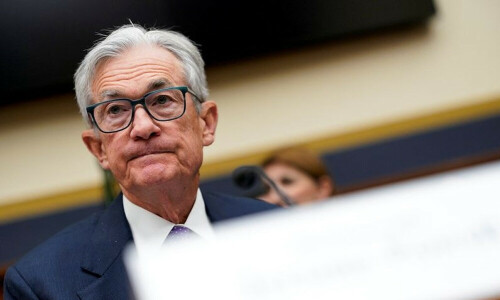Federal Reserve Maintains Steady Interest Rates Amid Economic Uncertainty
The Federal Reserve opted to maintain stable interest rates on Wednesday, aligning with widespread expectations. However, policymakers at the U.S. central bank signaled their continued anticipation of cutting borrowing costs by approximately 0.5% before the close of the year. This outlook is shaped by a deceleration in economic expansion and a projected decline in inflation.
Assessing the impact of the Trump administration’s tariff implementation, Fed officials have adjusted upwards their inflation forecasts for the current year. Their preferred metric for gauging price increases is now projected to reach 2.7% by year-end, a rise from the 2.5% forecast made in December. The Federal Reserve aims for a 2% inflation rate.
Concurrently, the growth forecast for this year has been revised downwards from 2.1% to 1.7%, with a slight uptick in unemployment anticipated by the year’s end.
According to policymakers, the risks have grown, with a strong consensus indicating a clouded outlook for the year ahead.
The Fed acknowledged heightened uncertainty in its updated policy statement, which considers the Trump administration’s initial weeks and the preliminary execution of tariffs on imported goods, envisioned by White House officials as eventually encompassing global trade. The central bank has kept its policy rate within the 4.25%-4.50% band.
Furthermore, the Federal Reserve announced its intention to moderate the ongoing reduction of its balance sheet, a process known as quantitative tightening.
Fed Governor Chris Waller expressed disagreement with the policy statement due to the adjustment in the balance sheet strategy.
Economic Projections
The anticipated rate projections were in line with financial market expectations leading up to the meeting. They also preserved the Fed’s overarching view that a gradual easing of inflation would pave the way for additional monetary policy easing.
Nevertheless, the path ahead could be turbulent. While the statement made no specific mention of President Donald Trump or tariffs, the upward revisions to this year’s inflation projections coincided with the unveiling of his tariff proposals.
For the moment, the Fed appears to be considering the price fluctuations associated with these import taxes as a transient phenomenon rather than a long-term source of inflationary pressures.
The projections for underlying inflation beyond 2025 remained unchanged from the December forecasts, with a projected return to 2% by the end of 2027.
The forecast for rate cuts beyond the current year also remained unchanged, settling at 3.1% by the conclusion of 2027, close to a level deemed to have a neutral impact, neither stimulating nor discouraging spending and investment.
Last year, the Federal Reserve lowered its benchmark interest rate by a full percentage point. However, it has maintained stable rates since December, awaiting further confirmation that inflation will continue its downward trend and, more recently, seeking greater clarity regarding the implications of the Trump administration’s policies.
In contrast to President Trump’s assurances of an impending economic “golden age” driven by his efforts to implement tariffs, deport a significant number of immigrants, and ease regulations, the Fed’s projections anticipate growth of 1.7% this year and only 1.8% in both 2026 and 2027. The unemployment rate is projected at 4.4% this year and 4.3% in both 2026 and 2027. These figures are higher than the recent lows and exceed the latest reading of 4.1% recorded in February.
Fed Chair Jerome Powell is scheduled to hold a press conference at 2:30 p.m. EDT to provide further details on the latest policy statement and projections.



Comments (0)
No comments yet. Be the first to comment!
Leave a Comment